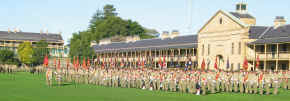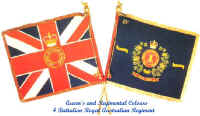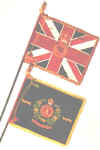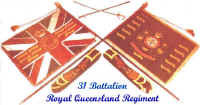- In the case of the Colours
being threatened it
was a soldier's duty to pick up the Colours and, at all costs,
save them. "Indeed
a greater act of cowardice cannot be found than to suffer the
Colours to be lost"
records Francis Grose in his Military Antiquities (1786-88 ).
- In
the old tradition, if a mortally wounded ensign wrapped the
Colours around his body and died with them, the Colours were
not considered lost. The honour of the Colours was carried
with the ensign's soul to heaven "to the possession of
the eternal forever" and the enemy was denied the honour
of having captured them.
|
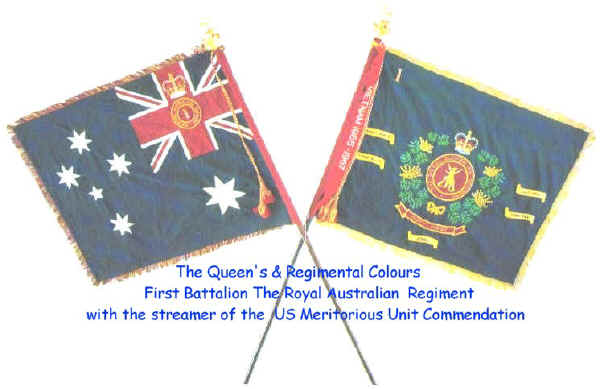 |
- The tradition of colours and
the strict conventions applied and the respect accorded them
must be a matter of common knowledge for every soldier.
- An officer or soldier
passing uncased Colours of his own regiment or other corps
or friendly service is to salute them.
- Colours are the jealous
possession of the battalion.
- They do not leave the
Battalion's possession even when it's on active service service.
- No one but the Battalion
may claim them.
- When they are being moved
from, or to, the place they are usually kept, they are to
be escorted.
- When the colours are not
being carried they are to be housed in the Officers
Mess.
- When the Battalion is on
active service or functioning in such a way that its
custody of the Colours is not possible, the Colours are
housed for safe keeping before leaving Australia.
- Gloves are to be
worn at all times while carrying the colours.
|
The Colours are the focal point of all
that make a regiment great. They are consecrated symbols embodying the
loyalty, spirit and traditions of the Regiment or Battalion to which they belong.
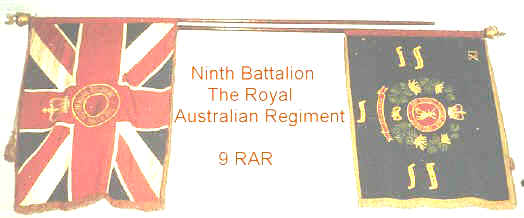
- The Sovereign’s Colour is a reminder to
all ranks of their loyalty and duty to their Sovereign and their
Country.
- The Regimental Colour is a symbol of Regimental tradition and
of the duty owed by each member to the Regiment.
- Battle Honours are
emblazoned on the Regimental Colour. In some cases the Battle Honours
are emblazoned on the Sovereign's Colour. There is a limit of 10
(11) Battle Honours on any Colour.
 for
full details in text for
full details in text
|
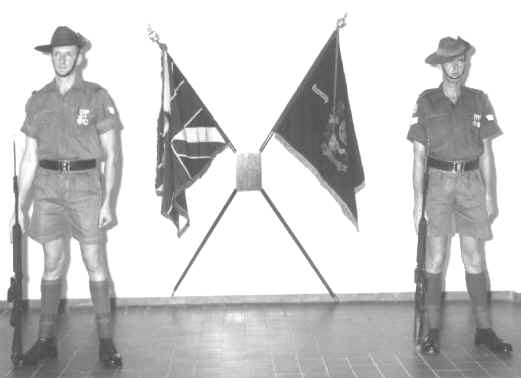
|
|
1RAR Queen's and Regimental Colours on display in
Singapore in 1970. |
- The Colours are always
guarded with a ceremonial Honour Guard of senior NCOs when on
parade and when on display at other times an armed guard
of NCOs is mounted over them.
- The very name Colour Sergeant
comes from the position within a Regiment whose role was to
organise protection of the Colours
- to this day the
Warrant Officers and senior
NCOs who form the Honour Guard (or Colour Guard) wear a scarlet sash over
the right shoulder to indicate their status. see
photo >>> and below
- the Colour Bearers ( the
ones who actually carry the Colours) are junior Officers and it is considered an honour to be
chosen. Some Units have a tradition of having the longest
serving Lieutenant bear the Queen's Colour and the
Lieutenant with the least service bear the Regimental
Colour.
|
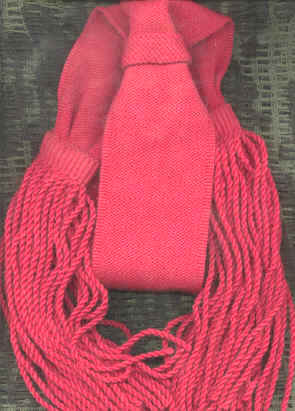 |
|
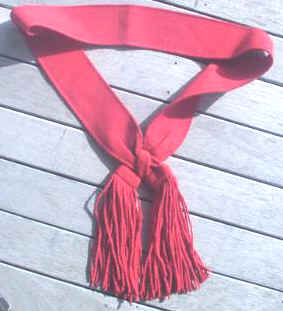
|
- The Infantry Scarlet
sash as worn by Duty Sergeants and Colour Party
"Colour Sergeants".
|
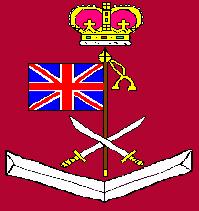 |
This
is a 1813 rank badge of the Colour Sergeant in the British
Army units serving in Australia. Note that 2 of the
traditional 3 stripes have gone to be replaced by crossed swords
and a representation of the Sovereign's Colour under the
Crown.
(This has never been a
rank in the Australian Army except in the Corps of Staff
Cadets at Royal Military College. It was a rank in the
Colonial Military Forces. see below)
|
- The rank of colour
sergeant was introduced into the British Army in 1813 as the
protector of the ensign and the Colour. There was no such rank
in the Australian Army except at the Royal Military College
Duntroon, where it was a rank within the Corps of Staff Cadets
and in pre Federation Colonial Forces.
-
The escorts in a Colour Party are often Staff-Sergeants and
for ceremonial occasions, when Colours are on parade, they are
referred to as the Colour
Sergeants.
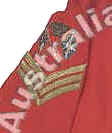 |
Badge
of Rank of a Colour Sergeant in the Kennedy Regiment
(Qld)1890/1898.
Note the 3 stripes,
crossed flags (both Union Jacks) surmounted by a crown.
Details |

|
Badge of Rank
of the Colour Sergeant in the Coldstream Guards, 2003 |
- The Sovereign's Colour was
traditionally based on the Union Flag but now, since the
middle 1970's, as the Queen's Colours are replaced they are
based on the Australian National Flag. see
the 1RAR colours at top of page for an example.
|
|
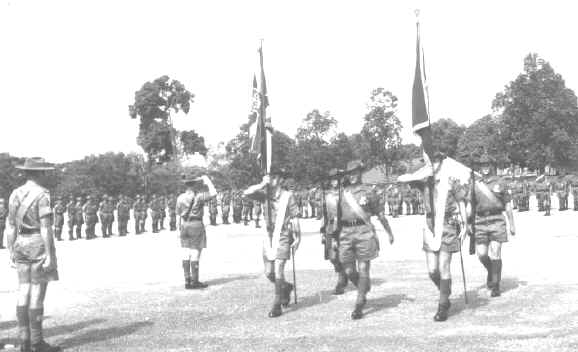
|
|
1RAR Colours on parade at the Battalion Birthday in
Malaysia in 1969. |
The origin of the symbols can be
traced back to the dim beginnings of history. Over 5000 years ago in
India there was the "Cult of the Standard". In the time of
Julius Caesar standards were made of metal, but with the advent of the
Christian era they were made of cloth, silk or damask.
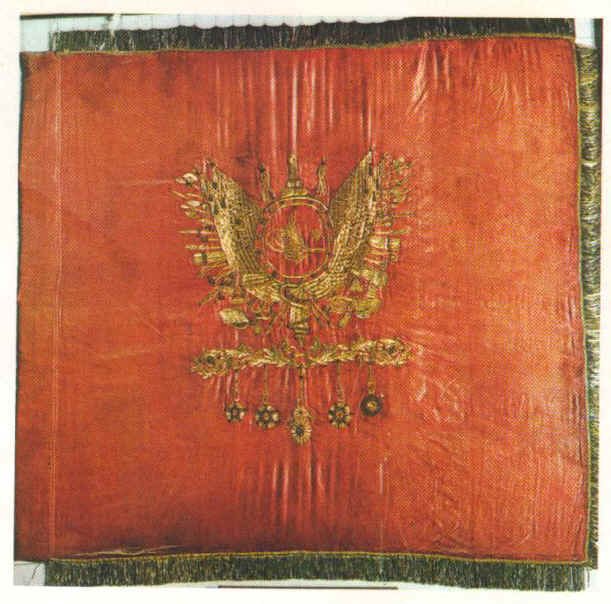
Regimental colours of
the 46th Turkish Regiment captured by Australians in 1918, the only
Regimental Colours ever captured by Australians
Early Military flags were of two
types: the personal flag borne in the feudal armies when service was
rendered to the immediate overlord, and the national or standardized
flag as borne by the National or standing armies. George III abolished
the personal aspect in 1743 when a warrant stated "No Colonel shall
put his arms, crest device or livery in any part of the appointments of
his Regiment". The same warrant directed the number of the Regiment
to be painted in the centre of the Regimental or second colour
inaugurating the Regimental aspect. Varying colours were carried by
Regiments until 1751 when it was decreed that only two colours would be
carried in future - The King’s (or Queen’s) and the Regimental
Colour.
The purpose of the standard was to
serve as a rallying point in the field of battle. When the distinctive
insignia was held aloft the troops knew the position of their leader. To
lose the standard often meant that one’s leader was lost. Therefore
the importance of "Keeping the flag flying" was very great.
With the introduction of modern
weapons the casualty rate among Colour and Standard Bearers was very
high. So high was the mortality rate of Colour Bearers during the
Crimean War that in subsequent European wars British Colours were not
carried.
- British Colours were last carried into battle
by the 58th Foot (later the 2nd Battalion The Northampton Regiment)
whose Colours were carried at Laing's Nek in the 1st Boer War on 28
January 1881. Lieutenant Alan Hill of the 58th, the Ensign carrying
the Queen's Colour, was awarded the Victoria Cross for rescuing on
his horse the mortally wounded Lieutenant Baillie carrying the
Regimental Colour. Baillie's
dying words were 'Never mind me; save the Colour'.
- Australian Colours have NEVER been
carried on a battlefield. They are reserved for ceremonial occasions
only.
|

